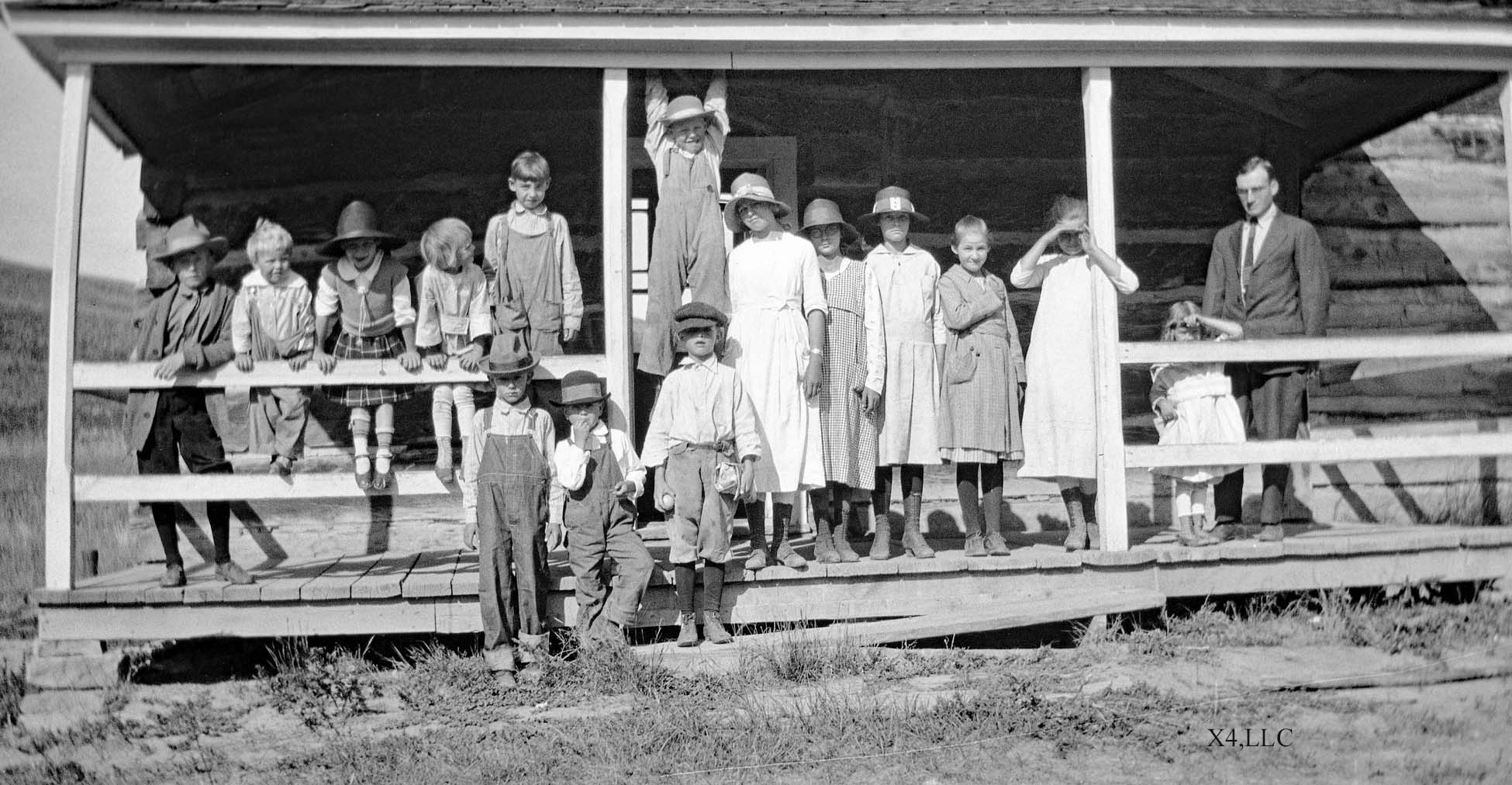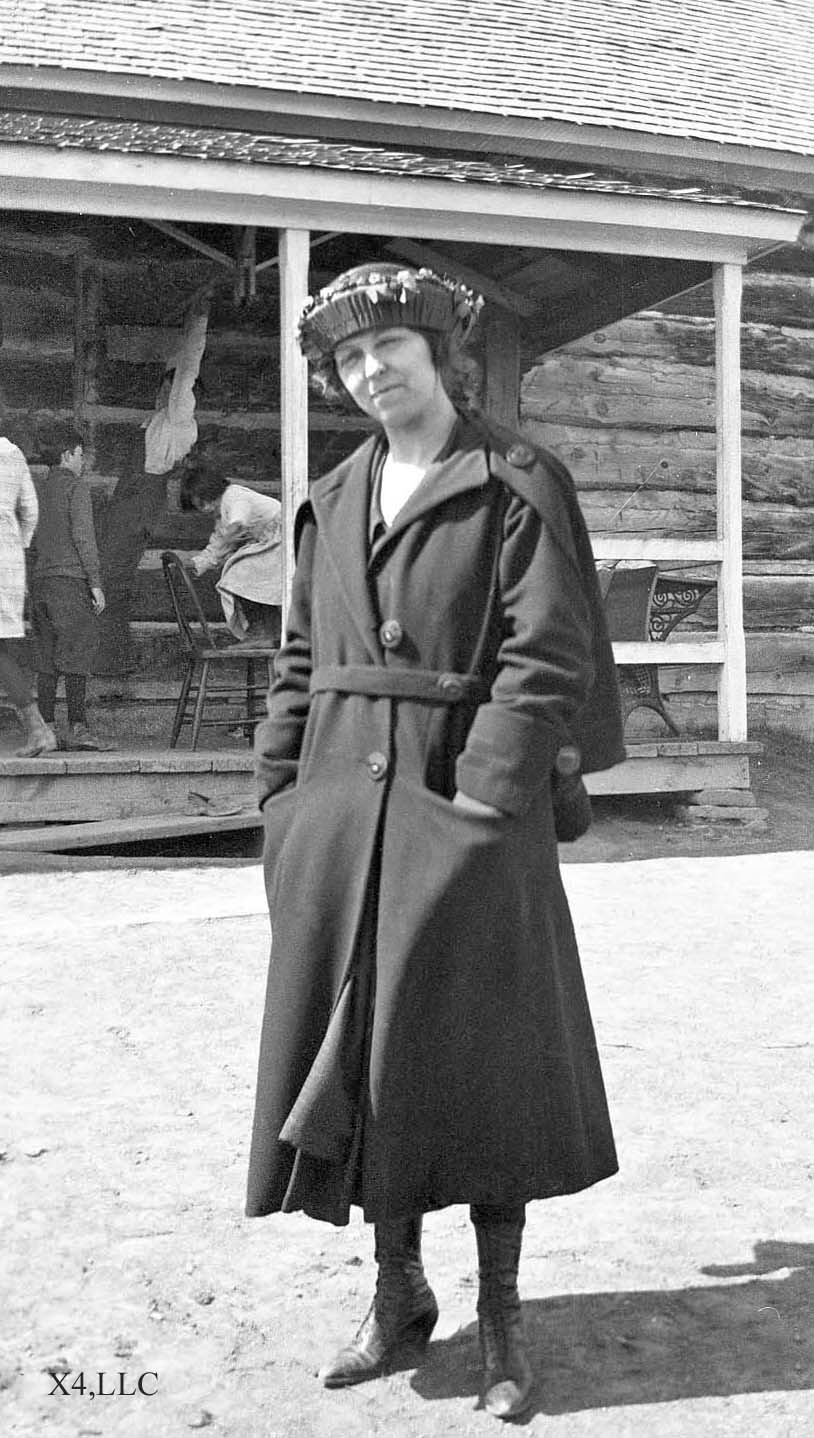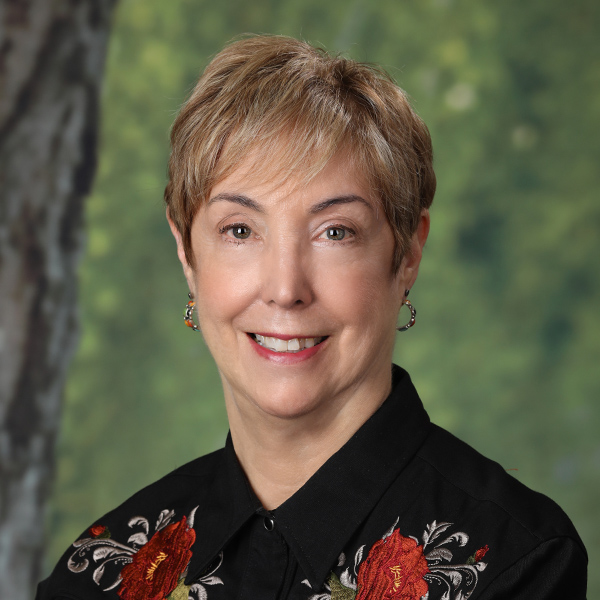The Log School House
Jun 09, 2022 by Tempe Javitz
The Log School House
Rural schools were the heart of their community.
As author Ivan Doig affirmed in The Whistling Season,
“the roads and trails leading to the country school
held together a neighborhood measured in square miles
and chimneys as far apart as smoke signals.”
In early 1919 Jessamine has three children at school
and two underfoot at home. Annabelle was nearly twelve
Phyllis was ten, and Bill was seven years old. Jessamine
had just settled in her new home when the school board
elected her as a Trustee for a three- year term. The local
school teacher, Miss Loretta Perry, was already boarding at
their home.
The local school was known as “The Log School House.”
Naturally it was a one room log building with a porch entrance.
Bill remembers driving a team to school with his sisters and
a five gallon can of water, as there was no water at the school.
When they ran out of water, they would walk to the spring at
Spring Creek and haul back a bucket of water. The teachers tried
to keep them from drinking from the Rosebud Creek, but Bill said,
"I did sometimes anyway." (All matter of cows and horses and
wildlife drank from the Rosebud.)
.jpg)
The Johnson children heading for school on their ponies.
For most rural schools, hiring and retaining a teacher who would
live with a ranch family and teach at a one room school house was
challenging. In early September of 1919, the trustees were still
searching for a new teacher. Jessamine noted on Tuesday, September
2nd, that she had spent the whole afternoon phoning for a teacher.
The following day she and Will went to Sheridan to see if they could
find someone, but they came home empty handed. Finally, on September
9th, Will brought a Miss Perry out to teach, but school didn’t begin
until Monday the 15th. To make sure the new teacher felt welcomed,
Jessamine held a reception at her home the following Saturday for the
parents to greet the new teacher.

Children at the Log School House, spring 1918.
Torrey remembers how the Cheyenne families with children attending
the Log School House would pitch their tents and stay with their
children during the week. The family would leave on Friday and
return on Sunday with needed supplies. Both parents would stay
with the children.
On April 25th, 1919, Eileen and little Torrey frightened everyone
when they ran off to school. They thought they were old enough to
join their brother and sisters.
.jpg)
Torrey & Eileen Johnson playing in an old wash tub.
During the 1920s Dr. Russell from Hardin visited the school several
times a year. He measured and weighed the children, then held meetings
with the parents to explain about proper hygiene and good nutrition--
not only for their children but the pregnant mothers in the community.
Schools then were essential to the success of public health efforts.
They were ideal locations for evaluating children’s health and holding
vaccination drives.
Mrs. Russell came with her husband on these visits. She and Jessamine
became good friends. On their first visit Jessamine cooked a fried
chicken dinner. The local skunk had visited the hen house the night
before. Cousin Dean had shot at it and missed. Everyone wisely
decided to save the chickens for the family to eat, and so they did.
In celebration Jessamine noted, “Mrs. Russell and I had quite a concert.
She played and I sang.”
It was not unusual for women to be superintendents in the Montana schools
after Helen Clarke and Alice Nichols became the first two-women elected
to that office in 1882. By 1890 ten more women had joined their ranks.
Since that time, the majority of the state’s county superintendents have
been women! In 1920 Miss Faye Alderson was Big Horn County’s
superintendent. She visited the Log School House on a regular basis.

Miss Faye Alderson in front of the Log School House.
As the number of children increased a second school was built at the bend
in Rosebud Creek near the Battle of the Rosebud site--across from the
Penson ranch. The Big Bend School opened in the fall of 1922. Both
schools would serve the Kirby community for a long time. By the time I
was in grade school in 1956, the Log School House was used only as a
community center, and all the local children attended Big Bend School.
Those of us living further north up Corral Creek had our own little red
school house that educated my three older siblings through eight grades.
By the time I reached fourth grade our family moved into Sheridan so my
sibs could be in high school. The little red school house was closed.
The Log School house continued in use for many years as a place for
picnics, dances and even an occasional movie. We also received our
annual tick shots each spring when the community had a pot luck dinner
and local entertainment.
Cowboy Jargon:
School Section: Starting in 1802, a section of land (one square mile)
out of every township was given by the federal government to each state
for the support of public schools. When not used for schools, these
sections were leased to ranchers for grazing and the income was used
for other schools.
Rural schools were the heart of their community.
As author Ivan Doig affirmed in The Whistling Season,
“the roads and trails leading to the country school
held together a neighborhood measured in square miles
and chimneys as far apart as smoke signals.”
In early 1919 Jessamine has three children at school
and two underfoot at home. Annabelle was nearly twelve
Phyllis was ten, and Bill was seven years old. Jessamine
had just settled in her new home when the school board
elected her as a Trustee for a three- year term. The local
school teacher, Miss Loretta Perry, was already boarding at
their home.
The local school was known as “The Log School House.”
Naturally it was a one room log building with a porch entrance.
Bill remembers driving a team to school with his sisters and
a five gallon can of water, as there was no water at the school.
When they ran out of water, they would walk to the spring at
Spring Creek and haul back a bucket of water. The teachers tried
to keep them from drinking from the Rosebud Creek, but Bill said,
"I did sometimes anyway." (All matter of cows and horses and
wildlife drank from the Rosebud.)
.jpg)
The Johnson children heading for school on their ponies.
For most rural schools, hiring and retaining a teacher who would
live with a ranch family and teach at a one room school house was
challenging. In early September of 1919, the trustees were still
searching for a new teacher. Jessamine noted on Tuesday, September
2nd, that she had spent the whole afternoon phoning for a teacher.
The following day she and Will went to Sheridan to see if they could
find someone, but they came home empty handed. Finally, on September
9th, Will brought a Miss Perry out to teach, but school didn’t begin
until Monday the 15th. To make sure the new teacher felt welcomed,
Jessamine held a reception at her home the following Saturday for the
parents to greet the new teacher.

Children at the Log School House, spring 1918.
Torrey remembers how the Cheyenne families with children attending
the Log School House would pitch their tents and stay with their
children during the week. The family would leave on Friday and
return on Sunday with needed supplies. Both parents would stay
with the children.
On April 25th, 1919, Eileen and little Torrey frightened everyone
when they ran off to school. They thought they were old enough to
join their brother and sisters.
.jpg)
Torrey & Eileen Johnson playing in an old wash tub.
During the 1920s Dr. Russell from Hardin visited the school several
times a year. He measured and weighed the children, then held meetings
with the parents to explain about proper hygiene and good nutrition--
not only for their children but the pregnant mothers in the community.
Schools then were essential to the success of public health efforts.
They were ideal locations for evaluating children’s health and holding
vaccination drives.
Mrs. Russell came with her husband on these visits. She and Jessamine
became good friends. On their first visit Jessamine cooked a fried
chicken dinner. The local skunk had visited the hen house the night
before. Cousin Dean had shot at it and missed. Everyone wisely
decided to save the chickens for the family to eat, and so they did.
In celebration Jessamine noted, “Mrs. Russell and I had quite a concert.
She played and I sang.”
It was not unusual for women to be superintendents in the Montana schools
after Helen Clarke and Alice Nichols became the first two-women elected
to that office in 1882. By 1890 ten more women had joined their ranks.
Since that time, the majority of the state’s county superintendents have
been women! In 1920 Miss Faye Alderson was Big Horn County’s
superintendent. She visited the Log School House on a regular basis.

Miss Faye Alderson in front of the Log School House.
As the number of children increased a second school was built at the bend
in Rosebud Creek near the Battle of the Rosebud site--across from the
Penson ranch. The Big Bend School opened in the fall of 1922. Both
schools would serve the Kirby community for a long time. By the time I
was in grade school in 1956, the Log School House was used only as a
community center, and all the local children attended Big Bend School.
Those of us living further north up Corral Creek had our own little red
school house that educated my three older siblings through eight grades.
By the time I reached fourth grade our family moved into Sheridan so my
sibs could be in high school. The little red school house was closed.
The Log School house continued in use for many years as a place for
picnics, dances and even an occasional movie. We also received our
annual tick shots each spring when the community had a pot luck dinner
and local entertainment.
Cowboy Jargon:
School Section: Starting in 1802, a section of land (one square mile)
out of every township was given by the federal government to each state
for the support of public schools. When not used for schools, these
sections were leased to ranchers for grazing and the income was used
for other schools.
